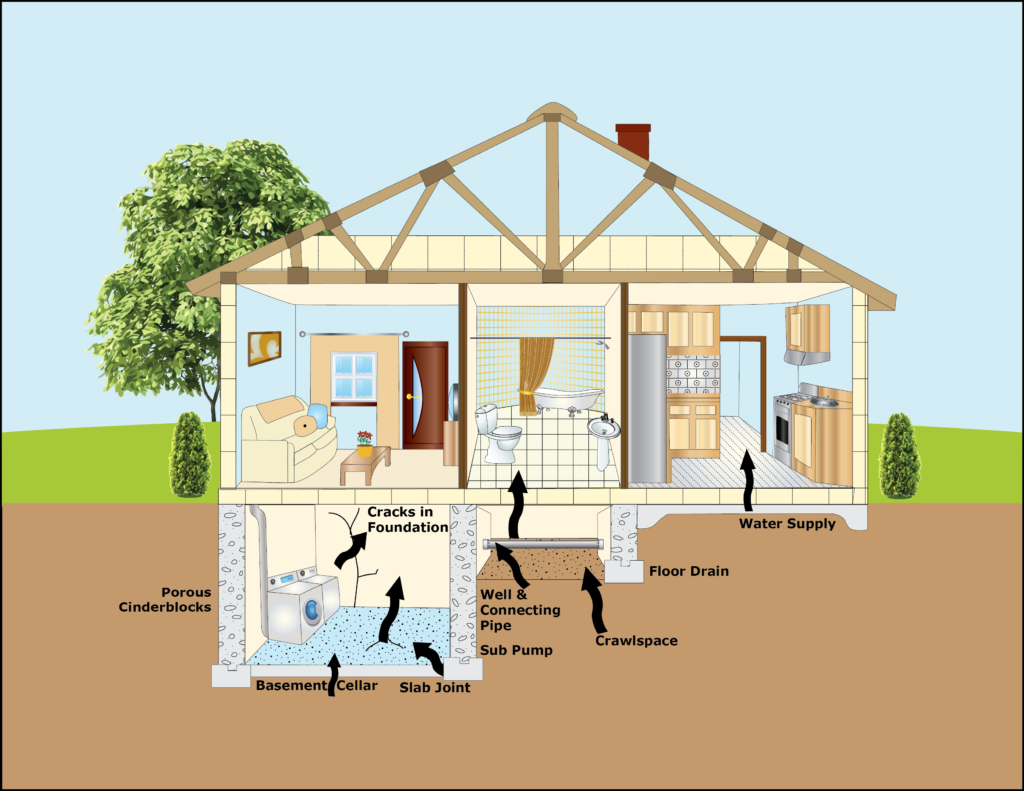Dr. Randi Pokladnik, PhD Environmental Studies

The first time I heard of radon gas was about thirty years ago. A neighbor who lived a few doors down the street from us in Toronto, Ohio was trying to sell her parents’ home. They had both passed away from cancer. Her realtor suggested she do a radon test before putting the house on the market. She did and when the results came back, she was shocked. The test kit showed the house had over 1000 piC/L (picocuries per liter of air)of radon gas. The actionable limit according to the US EPA is 4 piC/L. The actionable level means remediation procedures should be taken immediately.
Even though radon gas kills 20,000 people a year, testing for radon in schools and public buildings in Ohio is not mandatory. Anthony Russo, the President of Northern Ohio Inspections says radon “kills 20-30 times more people than accidental carbon monoxide poisonings every year.”
So, you may be asking “What is radon, why is it dangerous, and how does it get into my home?” Radon is a colorless, tasteless, odorless gas. It occurs naturally in two forms; Radon 222 and Radon 220. Both are part of the breakdown of radioactive Uranium or Thorium. It is usually found in igneous rock and soil but can also be found in water as it is soluble in both water and organic materials. Radon emits alpha particles or two protons and two neutrons. These positively charged alpha particles when exposed to human tissues produce “mutations, chromosome aberrations, generation of reactive oxygen species, modification of the cell cycle, up or down regulation of cytokines and the increased production of proteins associated with cell-cycle regulation and carcinogenesis.”
Radon can enter your home in a variety of ways, but it mainly comes through the underlying rock and soil around your basement walls and floor, or through your floor-on-grade if you don’t have a basement. Radon can move through any tiny crack in your foundation. Recent studies have shown that earthquakes and hydraulic fracturing or “fracking’ speed up the release of radon gas by breaking up underlying rock strata.
Regions with intense shale gas activity have seen significant increases of radon in surrounding homes. Recently, the industry has used deeper and longer horizontal drilling techniques which have triggered “significant earthquake activity.” This activity has been noted in Alberta, British Columbia, Ohio and Oklahoma.
“Researchers at Johns Hopkins Bloomberg School of Public Health found that radon levels in U.S. homes in Pennsylvania have been on the rise ever since fracking of the Marcellus shale began in 2004.” Radon released as a result of fracking can dissolve into well water and be found in natural gas. A study at the University of Toledo found, “the shorter the distance a home is from a fracking well, the higher the radon concentration. The larger the distance, the lower the radon concentration.”
Even though radon is a heavy gas that is nine times denser than air, it is a Noble gas and exists only as a single atom. This means it can penetrate paper, leather, sheet rock, tar paper and concrete. The gas can access upper levels of your home via vents and openings for pipes. Radon can also penetrate well casings and enter the home through faucets.
So how do you know if you are living in an area prone to higher radon levels? The EPA maps show all of Ohio’s counties do have radon gas, however you should conduct your own radon testing to determine if your home needs a radon system. While the United States Geological Society has mapped radon levels across the country and can point out hot spots, there is no definitive way to ascertain radon levels without a test kit. Ohio has a radon program and offers free test kits.
Test kits can also be purchased. They can be a canister style or one that looks like a 35 mm camera film case. You expose the test kit to the area you are testing for the prescribed amount of time. Then package the kit and send it to a testing lab. The test kits and lab analysis are less than fifty dollars and well worth the money for peace of mind. You can also purchase a plug-in digital monitor that displays a continuous radon level for about $130.
It is especially important to test for radon if you have a basement recreational room or have children’s bedrooms located in a lower level of the home. Children are more susceptible to radon gas as they have a higher respiration rate and their cells are dividing faster than an adult. Smokers are also at a higher risk for radon. The gas has been reported by the American Lung Association as the second leading cause of lung cancer.
Now what should you do if your testing results show above the safe limit? You can install a radon remediation system yourself or look for a certified contractor. When we built our home, we knew about radon and took the necessary steps to place a radon removal system in before the house was finished. All we did was dig the foundation a bit deeper, add gravel and place a heavy plastic sheet on the gravel before the floor was poured. We also placed a 4” PVC pipe into the gravel layer before the concrete was poured and ran the pipe through the basement wall. When the level of radon tested higher, we installed a fan that literally creates a vacuum under the basement floor and pumps the radon contaminated air from the gravel layer to the outside. We also purchased a continuous radon monitor which beeps when our level goes above 4 piC/L. You may be able to add a similar system in your home by coring a hole into your floor to insert a PVC pipe and then installing a fan.
Radon gas can become even higher in homes during the winter months as we keep windows closed shut and super insulate our homes against the cold. However, regardless of the season, radon will always be a part of our lives as it is a part of earth’s geological history. We cannot avoid it but we can keep it from affecting our health by performing a simple test and carrying out a few remediation steps.

You must be logged in to post a comment.